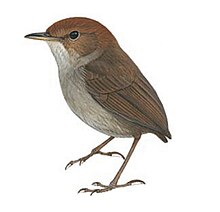Tesia
| Tesia | |
|---|---|
 |
|
| Russet-capped tesia | |
| Scientific classification | |
| Kingdom: | Animalia |
| Phylum: | Chordata |
| Class: | Aves |
| Order: | Passeriformes |
| Family: | Cettiidae |
| Genus: |
Tesia Hodgson, 1837 |
The tesias are a genus, Tesia, of Old World warbler. Though once included in the large family Sylviidae, more recent research placed it within a new family, Cettiidae. The four species inhabit undergrowth of montane forests in South and Southeast Asia, where they are resident or short-range migrants. They have longish legs and appear tailless, with (seemingly) only 8 rectrices. Their simple songs are fairly loud, and their nests are typically ball-shaped. Their name is derived from Tisi, the Nepalese name for T. cyaniventer.
The genus has a disjunct distribution in South and South East Asia. The three northern species range widely across southern China, Burma, Northern Thailand and Laos and into India, southern Nepal and Vietnam; whereas the other two species are found in Java and the Lesser Sundas in southern Indonesia. One species of tesia, the chestnut-headed tesia, which occupies the northern area of the genus' range, is now usually placed into the genus Cettia. The russet-capped tesia was once considered to be a race of the Timor stubtail, Urosphena subulata. The three northern species are sometimes known as ground-warblers.
Tesias are tiny ground-living warblers which range in length from 7–10 cm and weigh between 6-12 g. They have long legs and an upright stance, and appear to almost lack a tail, as their tail retrices are shorter than the tail coverts. The plumage of the northern species (except the Chestnut-headed) is olive backs and wings and grey bellies (darker slate in the slaty-bellied tesia); the southern species have brown wings and backs. All species have an eye-stripe and all except the slaty-bellied tesia have a supercilium; this is most prominent in the Javan tesia. The plumage of the chestnut-headed tesia is different from the other species; it has a bright yellow belly, chest and throat, and a deep chestnut coloured head and an incomplete white orbital ring. It lacks the facial stripes of the other species. The bill of all species is long and bicoloured, with a dark upper mandible and a flesh-coloured lower one, as well as strong ridge on the upper mandible.
...
Wikipedia
